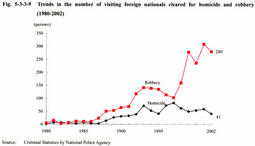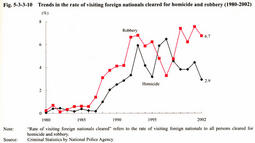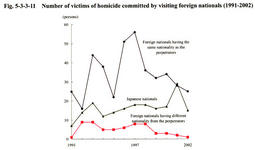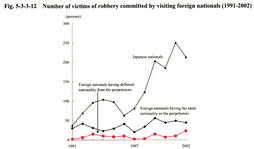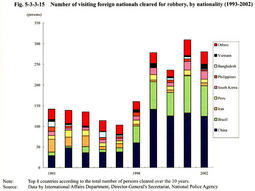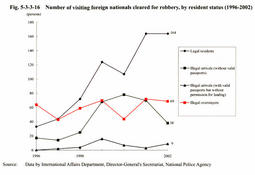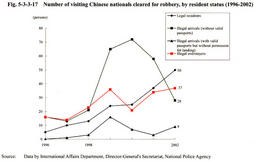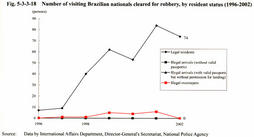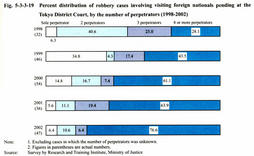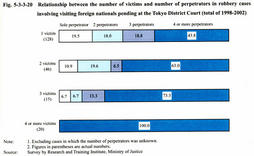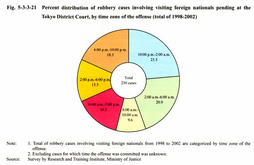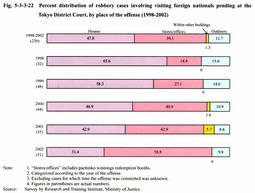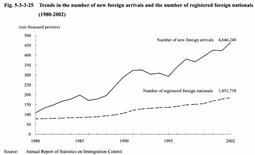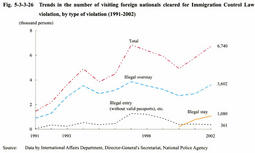| Previous Next Index Image Index Year Selection | |
|
|
2 Changes in foreign national offenders (1) Trends in heinous offenses committed by visiting foreign nationals The number of visiting foreign nationals has been increasing constantly and the number of visiting foreign nationals cleared for heinous offenses has also been on the rise accordingly. Fig. 5-3-3-9 and Fig. 5-3-3-10 show the number and percentage of visiting foreign nationals cleared for heinous offenses since 1980. The number of visiting foreign nationals cleared was on the rise from 1987 to 1993 both for homicide and robbery, but the number for homicide has been moving sideways after that period whereas the number for robbery has been rising sharply since 1998 after moving sideways, increasing 2.7-fold from 1997 to 2002. The percentage of visiting foreign nationals among all persons cleared has been on the rise since 1985 both for homicide and robbery, and moving sideways since 1992 and 1993 respectively, with some fluctuation.
Fig. 5-3-3-9 Trends in the number of visiting foreign nationals cleared for homicide and robbery (1980-2002) Fig. 5-3-3-10 Trends in the rate of visiting foreign nationals cleared for homicide and robbery (1980-2002) Fig. 5-3-3-11 , Fig. 5-3-3-12 , Fig. 5-3-3-13 , Fig. 5-3-3-14 show the trends in the number of victims of heinous offenses committed by visiting foreign nationals, by nationality, over the last 10 years, which is divided in the first half (1993-1997) and the second half (1998-2002). As for homicide the majority of victims had the same nationality as the perpetrators. The total number of victims has been declining whereas the percentage of Japanese victims has been increasing, up 11.1 points from the first half to the second half. As for robbery, more than 70% of the victims were Japanese nationals. The number of Japanese victims has been increasing along with the increase in the total number of victims, and from the first half to the second half, the percentage of Japanese victims increased by 7.4 points. This indicates that Japanese nationals have been targeted more frequently for robbery.Fig. 5-3-3-11 Number of victims of homicide committed by visiting foreign nationals (1991-2002) Fig. 5-3-3-12 Number of victims of robbery committed by visiting foreign nationals (1991-2002) Fig. 5-3-3-13 Percent distribution of victims of homicide committed by visiting foreign nationals Fig. 5-3-3-14 Percent distribution of victims of robbery committed by visiting foreign nationals (2) Trends in visiting foreign nationals who committed robbery, by nationality and resident status Recently, the number of robbery cases committed by visiting foreign nationals is increasing.
Fig. 5-3-3-15 show the trends in the number of visiting foreign nationals cleared for robbery in the 10 years since 1993, by nationality (top 8 countries according to the total number in the 10 years). The numbers of Chinese nationals and Brazilian nationals have been increasing significantly, collectively accounting for more than 70% of the total number since 1999. Fig. 5-3-3-16 , Fig. 5-3-3-17 , Fig. 5-3-3-18 show the trends since 1996 in the numbers of visiting Chinese nationals and Brazilian nationals cleared for robbery, who have recently been increasing significantly, by resident status. Among total visiting foreign nationals, the number of legal residents has been increasing rapidly whereas the number of illegal arrivals (without valid passports) has been decreasing after increasing and the number of illegal overstayers has been moving almost sideways. Among Chinese nationals, the numbers of legal residents and illegal overstayers have been increasing whereas the number of illegal arrivals (without valid passports) has been declining after a sharp rise but still accounting for a considerable share. The rise was influenced by the enforcement of mass clearance of illegal arrivals (without valid passports). Among Brazilian nationals, most are legal residents and the numbers of illegal overstayers and illegal arrivals (without valid passports) are quite small. Thus, there is a significant difference among visiting foreign nationals who have committed robbery with respect to their bases of living and social backgrounds, depending on their nationality. Fig. 5-3-3-15 Number of visiting foreign nationals cleared for robbery, by nationality (1993-2002) Fig. 5-3-3-16 Number of visiting foreign nationals cleared for robbery, by resident status (1996-2002) Fig. 5-3-3-17 Number of visiting Chinese nationals cleared for robbery, by resident status (1996-2002) Fig. 5-3-3-18 Number of visiting Brazilian nationals cleared for robbery, by resident status (1996-2002) (3) Actual conditions of visiting foreign nationals who committed robbery in Tokyo The occurrence of robbery is concentrated in metropolitan areas. Among others, according to the average over the last 5 years, 17.4% of all reported cases, 16.8% of all cleared cases, and 16.3% of all persons cleared in Japan were concentrated in Tokyo. This tendency is further remarkable with respect to robbery committed by visiting foreign nationals: 31.2% of all cleared cases and 29.2% of all persons cleared in Japan were concentrated in Tokyo (Source: Data by Criminal Investigation Bureau, National Police Agency). For this reason, by examining the characteristics of visiting foreign nationals who committed robbery in Tokyo, it is possible to clarify some characteristics of visiting foreign nationals who committed robbery in Japan in general. Investigation was made into the actual conditions targeting the 231 robbery cases involving visiting foreign nationals who were convicted at the Tokyo District Court over the 5 years from 1998 to 2002 (hereinafter referred to as the "target cases"). The following results have been obtained from the investigation.
[1] Over the 5 years, the average percentage of cases in which victims were killed or injured among the target cases was 45.7% while the average percentage of cases in which victims were killed or injured (severely or slightly) among all robbery cases was about 50%; there is not significant difference between the two. [2] Over the 5 years, the average accomplice rate among the target cases was high at 85.6%. More specifically, as shown in Fig. 5-3-3-19 , the number of perpetrators involved per case has been increasing, and the accomplice rate for cases involving 4 or more perpetrators reached a high level at 76.6% in 2002. Compared with the accomplice rates among all robbery cases, i.e. 20.9%-25.6% for adult offenders, 66.5%-75.1% for juvenile offenders, and 4.2%-6.9% (adult) and 23.1%-30.5% (juvenile) for cases involving 4 or more perpetrators, both the accomplice rate and the accomplice rate for cases involving 4 or more perpetrators (group perpetrator rate) were extremely high among the target cases. [3] Among the target cases, the percentages of those committed by sole foreign perpetrators, those committed by multiple foreign perpetrators, and those committed jointly by Japanese and foreign perpetrators were 16.9%, 67.2%, and 15.9% respectively. The number of cases committed by multiple foreign perpetrators was the largest but the number of cases committed jointly by Japanese and foreign perpetrators has come near to the number of cases committed by foreign perpetrators alone. [4] Fig. 5-3-3-20 shows the relationship between the number of victims and the number of perpetrators in the target cases. The percentages of cases involving 1 victim and 3 or more perpetrators and of cases involving 2 victims and 4 or more perpetrators were high at 62.5% and 63.0% respectively. This suggests that a large number of perpetrators often attacked a small number of victims whereas there are a considerable number of cases in which a group of perpetrators (4 or more perpetrators) attacked a group of victims (4 or more victims). [5] Fig. 5-3-3-21 shows the percent distribution of the target cases by time zone of the offense. Cases committed in the nighttime (from 6:00 p.m. to 6:00 a.m.) accounted for the largest part at 62.6% whereas those committed in the daytime accounted for 37.4%. Compared with the average percentage of cases committed in the daytime among all robbery cases over the 5 years, about 30%, the percentage of cases committed in the daytime is slightly larger among the target cases. [6] As shown in Fig. 5-3-3-22 , nearly 90% of the target cases were committed indoors, suggesting an remarkable concentration of indoor cases among the target cases, compared with the percentage of indoor cases among all robbery cases, which is slightly below 40%. Over the last 5 years, in the category of indoor cases, the percentage of cases committed in houses declined from 65.6% to 31.4% whereas the percentage of cases committed in stores/offices rose from 18.8% to 58.8%. This indicates that not only houses but also stores/offices have been targeted for robbery more frequently. [7] Table 5-3-3-23 shows the average amount of cash taken in cases committed by sole foreign perpetrators, cases committed by multiple foreign perpetrators, and cases committed jointly by Japanese and foreign perpetrators. A larger amount of cash was taken in cases committed by multiple perpetrators. [8] With respect to whether the offense was planned, over the 5 years, more than 90% of the target cases were committed following plans. [9] Table 5-3-3-24 shows the number of robbery cases in which each foreign defendant was involved (only counting the principal perpetrator for accomplice cases, for the purpose of avoiding overlap in counting). Most defendants committed robbery only once whereas there were many who committed robbery a series of times; among the 134 defendants, 38 persons committed robbery twice or more and 6 persons 5 times or more. These results of the investigation have revealed the following characteristics in the target robbery cases involving visiting foreign nationals convicted at the Tokyo District Court: the number of perpetrators involved per case was relatively large; not only houses but also stores/offices were targeted; the number of victims per case was large in many cases; robbery was committed according to plans. Furthermore, many of these cases were committed jointly by Japanese and foreign perpetrators or by the same perpetrators successively. Stores/offices have been targeted in more cases year by year. The increase in these robbery cases committed by multiple visiting foreign nationals seems to be likely to increase the number of victims and the amount of damage. Fig. 5-3-3-19 Percent distribution of robbery cases involving visiting foreign nationals pending at the Tokyo District Court, by the number of perpetrators (1998-2002) Fig. 5-3-3-20 Relationship between the number of victims and number of perpetrators in robbery cases involving visiting foreign nationals pending at the Tokyo District Court (total of 1998-2002) Fig. 5-3-3-21 Percent distribution of robbery cases involving visiting foreign nationals pending at the Tokyo District Court, by time zone of the offense (total of 1998-2002) Fig. 5-3-3-22 Percent distribution of robbery cases involving visiting foreign nationals pending at the Tokyo District Court, by place of the offense (1998-2002) Table 5-3-3-23 Amount of cash taken in robbery cases involving visiting foreign nationals pending at the Tokyo District Court and the composition of the perpetrators (total of 1998-2002) Table 5-3-3-24 Number of robbery cases in which visiting foreign nationals pending at the Tokyo District Court were involved, per capita (1998-2002) (4) Background factors behind the increase in the number of robbery cases committed by visiting foreign nationals Fig. 5-3-3-25 shows the trends in the number of visiting foreign nationals who entered Japan through legal procedures and the number of registered foreign nationals. As shown in Fig. 5-3-3-26 , there have been a number of foreign nationals who illegally entered Japan and were cleared for Immigration Control Law violation. There seem to be a number of unreported foreign nationals who illegally entered Japan. The increase in the number of such new arrivals as well as the increase in the number of illegal overstayers among persons cleared (more than 70% of illegal overstayers who were subjected to deportation were recognized as staying in Japan for the purpose of illegal employment; Source: Data by Immigration Bureau, Ministry of Justice) are regarded as background factors behind the increase in the number of foreign robbery offenders. Economic difficulties arising from a shortage of jobs due to the recession may also have a considerable influence.
The investigation into the foreign robbery offenders cleared in Tokyo has revealed that a considerable share of the robbery cases involving visiting foreign nationals were committed jointly by Japanese and foreign perpetrators. This situation has resulted not only from the increase in opportunities for more visiting foreign nationals to interact and live with Japanese nationals but also from the cooperation between robbery or theft groups consisting of visiting foreign nationals and Japanese organized crime groups, which has caused successive organized robbery cases. The occurrence of robbery cases based on the cooperation between visiting foreign nationals and Japanese organized crime groups suggests a new dangerous trend of international combination between organized crime groups, which has not been seen in the past, and caution should be exercised to this trend (for details, see Chapter 5 ). Fig. 5-3-3-25 Trends in the number of new foreign arrivals and the number of registered foreign nationals (1980-2002) Fig. 5-3-3-26 Trends in the number of visiting foreign nationals cleared for Immigration Control Law violation, by type of violation (1991-2002) |
